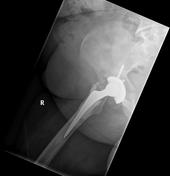Presentation
Loose right femoral component.
Patient Data




Bilateral cemented total hip prosthesis. Ideally comparison would be made with previous films but note the steepness of the right acetabular cup compared to the more normal angle of approximately 500 to horizontal on the left. This may be due to poor positioning at the initial surgery or because the cup has rotated.
Lucent regions are seen between the cement and bone along the mid and distal femoral stem. There is also lucency between the shoulder of the right femoral stem and the greater trochanter indicating subsidence. Findings are those of loosening of both the right acetabular and femoral components. The left hip replacement is normal.




 Unable to process the form. Check for errors and try again.
Unable to process the form. Check for errors and try again.